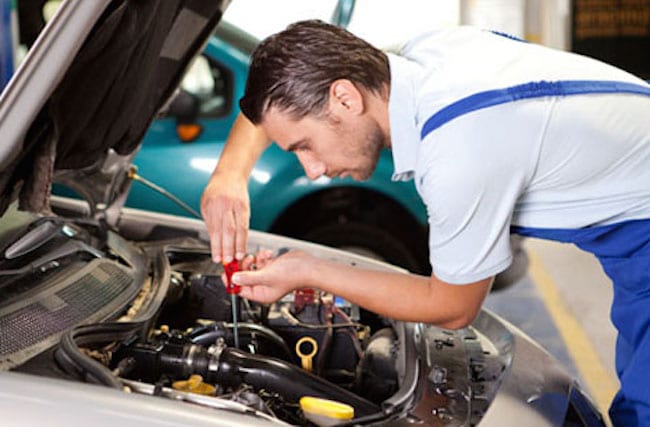If you noticed that your car is struggling, it can be difficult to identify the source of the issue. It’s unlikely that you’ll open the hood and immediately identify the faulty part, but hopefully our guide can you assist when you attempt to fix the mechanics in the future.
If you’re seeking an auto engine repair shop or any kind of car fix, check out our guide to see which part may be responsible…
Oxygen Sensor
As Keith Griffin of About.com explains, your vehicle’s oxygen sensor part can “negatively impact fuel economy by as much as 40 percent,” and this can impact a variety of drivers, as it is one of the most common repair among cars. Featured in the exhaust manifold, the tool monitors the amount of unburned oxygen that is still in the exhaust once its been removed from the engine. These oxygen levels help determine whether the fuel mixture is burning “rich” (featuring significantly less oxygen) or “lean” (featuring significantly more oxygen).
Why is this notable? Gasoline-powered engines use a combination of air and fuel to burn as efficiently as possible. Following combustion, the oxygen sensor basically determines whether the fuel is being wasted or not. If this part isn’t functioning properly, you could unknowingly be reducing your vehicle’s fuel efficiency, and thus losing yourself a chunk of money.
You can identify when your car’s oxygen sensor is failing by how the car is functioning. If you notice that your vehicle is either struggling while idling or jerking while reaching high speeds, this could be an indication of a failure. Regardless, your car should notify you via the check engine light.
A typical oxygen sensor repair will typically cost you around $250. Like the other parts mentioned on this list, there’s no avoiding a replacement, as the sensor is essential to your car’s operations.
Catalytic Converter
You’ve probably heard the catalytic converter mentioned by mechanics and car enthusiasts, but we wouldn’t be surprised if you have little idea what the essential part actually does. To put it simply, the “vehicle emissions control device” essentially grabs the pollutants in your gas and turns them into less toxic pollutants. To get the expected result, the catalytic converter will then catalyze a redox reaction, meaning the exhaust shouldn’t be as bad for the environment. Specifically, the converter removes carbon monoxide, nitrogen oxide, and hydrocarbons from the gas, helping prevent the development of poisonous gasses, smog and acid rain.
Unfortunately, it’s not particularly easy to identify when this part isn’t operating properly. Mechanics are often required to remove the entire converter to determine whether it’s functioning or not, so it’s doubtful that you’ll immediately be able to pick up on the issue. Trouble accelerating could be an indication that the part is failing, as would a drop in fuel efficiency. If the problem lingers and gets worse, the increased exhaust will prevent your engine from even running.
A broken catalytic converter could be the result of the driver having used lead gasoline, and over-use of fuel additives could also compromise the system. A failing exhaust valve or “fouled plugs” (which cause all unburned fuel to overheat the part) could also be having a vicarious, negative effect on your car’s catalytic converter.
If replacement of the part is covered by your accompanying warranty, you’ll want to get down to a mechanic as soon as possible. The positive? It’s a relatively common fix, and CarMD listed it as the second-most common repair. The negative? It’s going to set you back financially, as the part is estimated to cost around $1,150. Unfortunately, it’s as important as any part on this list, and you’ll be eyeing a pricier mechanic bill if you don’t get it repaired.
Loose Fuel Cap
It may sound silly, but a broken fuel cap can actually diminish your vehicle’s fuel efficiency, as just the tiniest crack can allow the gas to escape and evaporate. This was a fairly common issue among drivers in 2013, as broken fuel caps represented 7.17-percent of repairs.
The fix is relatively inexpensive, especially when the cap just needs some additional tightening. Even if the entire cap actually needs to be replaced, it should only put you out a couple of dollars.
You may be imagining yourself going to a store, purchasing a cap and replacing it yourself, but that could ultimately lead to similar issues. It’s a better idea to leave the work to a professional, assuring that your gas tank will always be properly sealed.
Ignition Coils/Spark Plugs
The fourth-most common repair for used cars, both of these parts are essential in igniting the fuel. The coil, which sits in the ignition system, grabs the battery’s low voltage and transforms it into thousands of volts of electricity. This is subsequently sent to the spark plug, where an electric spark helps ignite the fuel. When you hear a car commended for it’s excellent “electrical performance,” there’s a pretty solid chance that the spark plugs (and, vicariously, the ignition coils) are doing their job properly.
If your ignition coils are failing, the driver will be handed an assortment of warning signs. If you notice that your vehicle is backfiring, this could be an indication that unused, non-ignited fuel is being pushed through the exhaust system. You may also find that your vehicle is having difficulties starting, the vehicle is stalling, or the engine is misfiring. Similar to the other issues on this list, you may find that your fuel economy is also dropping.
The symptoms of a dying spark plug are pretty easy to catch. If you notice your engine is either vibrating or letting out a bizarre sound while you’re idling, that could certainly be an indication. A lack of a spark could also prevent your engine from even starting, and it could also make your car stall. Furthermore, you may notice an issue with acceleration, as well as a surging engine (when the vehicle jerks around or starts and stops frequently). Of course, a bad spark plug will also lead to you wasting plenty of money on unused gas.
If you find yourself needing to replace these two important parts, expect to spend at least $400. Without the ignition coils or spark plugs, it’s doubtful that you’ll even make it out of your garage.
Mass Air Flow Sensor
Another essential, lesser-known part, the mass air flow sensor is responsible for measuring the amount of air being sent to the engine, which subsequently determines how much fuel should also be sent. If this isn’t working properly, it can result in a 10-percent to 25-percent drop in fuel economy!
Getting the sensor replaced could actually be avoided with some previous planning. If a driver decides to not replace their vehicle’s air filters, that could compromise the quality of the mass air flow sensor. Instead of originally dishing out the $25 that was originally required, you’ll instead be facing a $400 bill.
Spark Plugs
The spark plugs, which help light up the fuel in the cylinders, are such a small part of your car’s system, but they can make a major negative impact if they’re not fixed. While replacements are typically cheap (around $10), it’s a better idea to leave the task to a professional.
What’s the worst that can end up happening? If spark plugs aren’t operating effectively (perhaps due to improper installation), they can reduce your gas mileage. Furthermore, they could melt and destroy the catalytic converter. As we mentioned previously, this can be a costly fix, so dedicating a little attention and a little cash to your spark plugs may save you down the road.
Of course, there are a variety of other car parts that could contribute to your struggling vehicle. Regardless, it’s always a good idea to leave the fixes up to a professional. Even if you can identify the issue, consider getting it fixed at a local mechanic or dealership service department.










